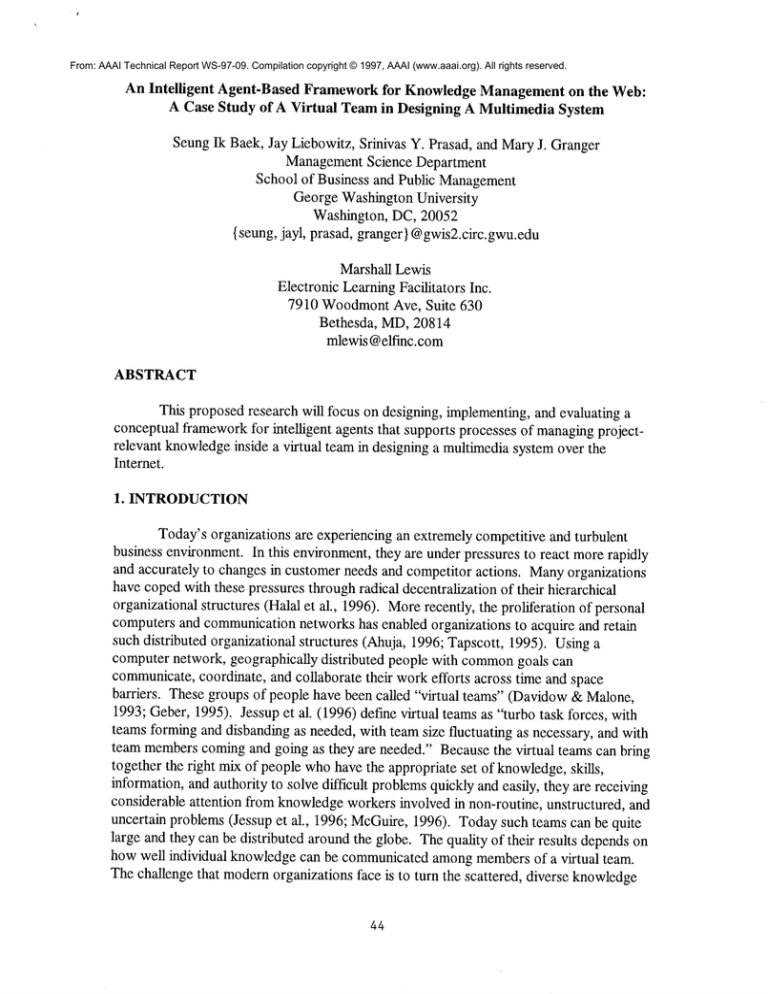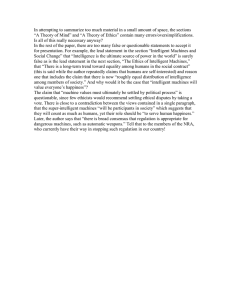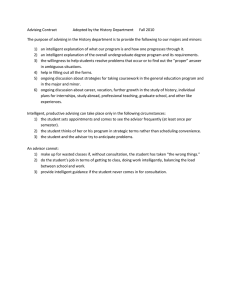
From: AAAI Technical Report WS-97-09. Compilation copyright © 1997, AAAI (www.aaai.org). All rights reserved.
An Intelligent Agent-Based Frameworkfor KnowledgeManagementon the Web:
A Case Study of A Virtual Teamin Designing A Multimedia System
SeungIk Baek, Jay Liebowitz, Srinivas Y. Prasad, and MaryJ. Granger
ManagementScience Department
School of Business and Public Management
George Washington University
Washington, DC, 20052
{ seung, jayl, prasad, granger} @gwis2.circ.gwu.edu
Marshall Lewis
Electronic LearningFacilitators Inc.
7910 WoodmontAve, Suite 630
Bethesda, MD,20814
mlewis @elfmc.com
ABSTRACT
This proposedresearch will focus on designing, implementing,and evaluating a
conceptual frameworkfor intelligent agents that supports processes of managingprojectrelevant knowledgeinside a virtual team in designing a multimediasystem over the
Internet.
1.
INTRODUCTION
Today’sorganizations are experiencing an extremely competitive and turbulent
business environment.In this environment,they are under pressures to react morerapidly
and accurately to changes in customer needs and competitor actions. Manyorganizations
have copedwith these pressures through radical decentralization of their hierarchical
organizational structures (Halal et al., 1996). Morerecently, the proliferation of personal
computersand communicationnetworks has enabled organizations to acquire and retain
such distributed organizational structures (Ahuja, 1996; Tapscott, 1995). Using
computer network, geographically distributed people with common
goals can
communicate,coordinate, and collaborate their workefforts across time and space
barriers. These groups of people have been called "virtual teams" (Davidow& Malone,
1993; Geber, 1995). Jessup et al. (1996) define virtual teams as "turbo task forces, with
teams formingand disbanding as needed, with team size fluctuating as necessary, and with
team memberscomingand going as they are needed." Because the virtual teams can bring
together the right mixof people whohave the appropriate set of knowledge,skills,
intbrmation, and authority to solve difficult problemsquickly and easily, they are receiving
considerable attention from knowledgeworkers involved in non-routine, unstructured, and
uncertain problems(Jessup et al., 1996; McGuire,1996). Todaysuch teams can be quite
large and they can be distributed aroundthe globe. Thequality of their results dependson
howwell individual knowledgecan be communicatedamongmembersof a virtual team.
Thechallenge that modernorganizations face is to turn the scattered, diverse knowledge
of their knowledgeworkerswhoare workingin a virtual team into a well-structured
knowledgerepository (Spek & Spijkervet, 1996; Wiig, 1993). KnowledgeManagement
(KM)is suggested as a methodologytbr creating, maintaining and exploiting a knowledge
repository (Stewart, 1995; Wiig, 1993). KMis defined as the collection of processes that
support the creation, dissemination, and utilization of knowledgebetweenappropriate
individuals, groups within an organization, and independentorganizations (Liebowitz
Wilcox, 1997).
The recent popularity of the WorldWideWeb(Web)has provided a tremendous
opportunity to expedite the dispersement of various knowledgecreation/diffusion
infrastructures (Chen&Gains, 1997; Ives & Jarvenpaa, 1996). Because the Webenables
organizations to create a knowledgerepository and to extend the scope of collaboration in
an easy and cost-effective manner,it creates the possibility of developingglobal
collaborative KMplatforms (Barua et al., 1995; Davenport, 1996). However,the
unstructured nature of the Webcreates an information overload problem. While the Web
allows various kinds of knowledgeto be created and disseminated across time and space
barriers, it does not support the processes of using and updating the knowledgein a timely
manner.Rasmus(1996) and Silvermanet al. (1995) suggest the use of intelligent agents
as a promisingsolution for assisting and facilitating these processes. This research will
focus on developing a conceptual model for KMand a frameworkfor the roles of
intelligent agents in the conceptual KMmodel. Furthermore,it will implementand
evaluate the intelligent agent-based frameworkon the Webunder a collaborative
environmentfor designing a multimediasystem.
2.
DATA, INFORMATION, VERSUS KNOWLEDGE
Dataconsists of facts and figures that are relatively meaninglessto the user.
Information is data that have been shaped or formedby humansinto a meaningfuland
useful form. Knowledgeis the stock of conceptual tools and categories used by humans
to create, collect, store, and share information. Whendata is processed, it can be
converted into information. Likewise, wheninformation is processed, it can be
knowledge.To create knowledgein organizations, managersmust managethe processes
that transform data into knowledge.Knowledge
management
includes all of the activities
involved in managingthe processes. Table 1 showsdefinitions of data, intbrmation, and
knowledgein the context of multimediasystems design.
<Table 1: Data, Inlbrmation, Knowledge, and KnowledgeManagementin Multimedia Systems Design>
Text, Audio, Video,
Number, and Graphics
that are closely related to
a specific topic.
1) What information
should be contained
(Content).
2) Howthe information
should be presented
(Treatment).
45
A methodfor systematically
and actively managingand
leveraging design ideas and
decisions amongteam
memberswhile developing
storyboards.
3.
AN INTELLIGENT AGENT-BASED FRAMEWORK
FOR KM
To developthe frameworkof intelligent agents for KM,a series of analysis steps is
conducted: 1) build a conceptual modelfor KMin order to discover problemsand
opportunities for intelligent agents; 2) specify howintelligent agents performthe tasks
identified in the previous step; and 3) finally modelhowthe intelligent agents cooperatein
order to assist KMactivities.
3.1 A Conceptual Model of KMin Designing A Multimedia System
Spekand Spijkervet (1996)identify three basic activities necessaryto build a wellstructured knowledgerepository: creating knowledge,securing/combining knowledge,
and distributing/retrieving knowledge.
3.1.1 Creating Knowledge
Whendesigning a multimediasystem, designers, developers and users, with their
ownunique group and individual perspectives, create one or moredesign solutions
consistent with the user requirements. Wheneverdesign participants gain a new
understanding about user requirements, they develop newdesign knowledge.The design
knowledgeis refined continually by other group membersthroughout a design process. A
highly expressive, precisely defined set of attributes for design knowledgerepresentation
can facilitate the ability to create newknowledgein a knowledgerepository.
3.1.2 Securing/Combining Knowledge
Since multimediasystems design is multi-disciplinary, enhancingteam
collaboration is extremelyimportant in the design process. It can be achieved only when
all team membersshare the sameknowledge,understandit clearly, and freely integrate
their knowledgeinto existing knowledge.All these can happenby storing and indexing
knowledgeproperly. Throughouta process of multimediasystems design, partially or
completely specified newdesign knowledgeshould be evaluated by checking whether or
not it is consistent and specifying howit should be integrated with the knowledgealready
stored in a knowledgerepository. By constructing a well-designed ontologythat specifies
at a high level what kinds of terminologyare frequently used and what their general
properties are in multimediasystemsdesign, design participants can properly integrate
their knowledgeinto an existing knowledgerepository.
3.1.3 Distributing/Retrieving Knowledge
Collaborative design process is fundamentallya learning process. Designteam
memberscan cometo a working understanding about a multimedia system by continually
learning from each other. To support the collaborative learning for design, there needs to
be open, flexible, and reactive communicationchannels to distribute knowledge.The gap
46
betweenthe evolving and continually changing, design knowledgecan hinder effective
collaborative learning.
A knowledgeretrieving activity can be executed whena designer seeks pieces of
knowledgethat are required to perform one’s tasks. Normally, a knowledgeretrieving
activity is based on one or morekeywords.In a rapidly changingenvironment,such as an
environmentfor designing a multimediasystem, keyword-basedknowledgeretrieving is
no longer productive. The dynamicnature of such an environmentrequires content-based,
context-based knowledgeretrieving. A well-designed ontology enables designers to do
content-based and context-based knowledgeretrieving.
Heijst et al. (1996) state that by streamliningthese processes an organization can
implementKMsuccessfully. Especially, in the case of designing a multimediasystem
whichrequires multi-disciplinary, ill-structured, highly creative knowledge,the continuous
streamlining of the three KMprocesses is important. Figure 1 showsa conceptual model
of KMin designing a multimediasystem.
<Figure 1: An Overview of KMProcess>
Creating
Knowledge
Create
Knowledge
Securing/
Combining Knowledge
I ’i
Refine
i
Knowledge
i
Retrieving
Knowledge
r| .....................................................
![valuat
i~- Knowledge
¯ Knowledge
I
L
Index
Knowledge
Consolidate
Knowledge ]
I
Store
Knowledge
Knowledge
i
Repository
i
Add
~L
Comments/r
AnnotationsI
Display J
!1 Knowledge
......................................................¢
Distributing Knowledge
47
3.2 KMAgents
To enhance knowledgeflow in a conceptual KMmodel, three intelligent agents are
specified: user agent, a knowledgemanager, and knowledgeagent. Table 2 summarizes
the majorroles of three intelligent agents in supportingKM.
<Table 2: Roles of Intelligent Agents in Supporting KM>
Creating
Knowledge
Byspecifying attributes in
a knowledge submission
form, users must be able to
represent their knowledge
fully.
User Agent
¯
¯
¯
Securing/
Combining
Knowledge
Distributing
Knowledge
Retrieving
Knowledge
4.
Users need to have the
ability to assemble,
customize, and extend
attributes and their values
defined in a knowledge
repository.
Users need to be aware
dynamic changes occurred
in a knowledgerepository.
Knowledge Agent
¯
¯
¯
Knowledge Manager
¯
Users need to search
knowledge in a knowledge
repository based on
attributes (or context) and
contents.
Knowledge Manager
¯
¯
Help users to create
knowledge and
formulate queries.
Remember all KM
activities of users.
Dynamically organize
a person’ s agenda.
Index knowledge.
Detect inconsistency.
Save, retrieve, and
update knowledge
from a knowledge
repository.
Monitor all changes
that occurredin a
knowledgerepository
and Ibrward them to
the user agent.
Reformulate queries
based on an ontology.
Determine the most
favored alternative
based on preference
weighting and
ranking.
IMPLEMENTATION
KMagents consist of three major components:dialog structure, inference engine,
and knowledgebase. Their dialog structures and inference engines are implementedusing
Javascript. And, their knowledgebases are implementedusing Cold Fusion and
Microsoft’s Access. The KMagents run on a WindowNTserver. Table 3 summarizes
structures of the KMagents.
48
<Table3: Structures of KMAgents>
User Agent
KnowledgeManager
KnowledgeAgent
5.
Interface for Usersand Backward-Chaining
KnowledgeManager
Interfaces for User
Meta-Knowledge/
Agent and Knowledge Control Knowledge
A~ent
Interface for KnowledgeExhaustiveSearch and
Rating
Manager
¯
Knowledgeabout
users
¯
Ontologyfor design
knowledge
¯
Knowledgeabout
storyboards
CONCLUSION AND FUTURE WORK
This research proposes an intelligent agent-based framework for supporting KM
on the Web. Manyintelligent agents have been developed for assisting users to retrieve
knowledge from the Web. However, few intelligent agents have been developed for
supporting other KMactivities (i.e., knowledgecreating, knowledgedistributing, and
knowledge securing, and knowledge combing). The framework proposed in this research
is designed for supporting and streamlining all KMactivities.
The next goal of this research is to validate the frameworkin a real-world setting.
Morespecifically, by using an exploratory research methodologythe research investigates
howeffective the Web, intelligent agent-based KMsystem can assist KMactivities in
designing a multimedia system. The case study will be conducted in a multimedia
company. During the case study, the Web, intelligent agent-based KMsystem will be
implemented and used for supporting a virtual team engaged in designing a mid-sized,
educational multimedia system. The system will be used mainly for communicating and
sharing key ideas and design decisions amongteam memberswhile developing
storyboards. The storyboard - a frame-by-frame matching of hand-drawn images and
pencil-in text - is essential for each memberof the team to bind together all the individual
design efforts (Kiddoo, 1992). The system will help design team membersto create,
exchange, and share their storyboards in a virtual team.
49
6.
REFERENCES
Ahuja, M.K.(1996), "An Empirical Study of Networkand Individual Performance
Distributed Design Groups," WorkingPaper, University of Pittsburgh.
Barua, A., Chellappa, R. and Whinston,A.B. (1995), "Creating A Collaboratory
Cyberspace: Theoretical Foundation and AnImplementation," Journal of Organizational
Computing,5(4), pp. 417-442.
Chen, L.L. and Gaines, B.R. (1997), "A Cyber Organization Modelfor Awareness
Collaborative Communitieson the Internet," Forthcomingin International Journal of
Intelligent Systems.
Davenport, T.H. (1996), "SomePrinciples of KnowledgeManagement,"Strategy,
Management,Competition, Winter, pp. 34-40.
Davidow,W.H.and Malone, M.S. (1993), The Virtual Corporation, Harper Business,
New York.
Geber, B. (1995), "Virtual Team,"Training, April, pp. 36-40.
Halal, W.E.(1996), The NewManagement,Berrett-Koehler Publishers, San Francisco,
CA.
Heijst, G., Spek, R. and Kruizinga, E. (1996), "Organizing Corporate Memories,"Tenth
KnowledgeAcquisition for Knowledge-BasedSystems’ Workshop.
Ives, B. and Jarvenpaa, S.L. (1996), "Will the Internet Revolutionize BusinessEducation
and Research?" Sloan ManagementReview, Spring, pp. 33-41.
Jessup, L., Valcich, J., Dennis, A. and Wheeler,B. (1996), "Real-TimeCollaboration
the World WideWeb:Supporting Virtual TeamsAcross Space and Time," Proceedings of
AmericanInformation Systems’ (AIS) Conference, Available as [http://hsb.baylor. edu/
ramsower/ais, ac. 96/p ape rs/LENA
IS 96. htm]
Kiddoo, K. (1992), "Discovering The Rules: Initiative
Project Design," MultimediaReview, 3(4), pp. 46-51.
and Teamwork
in Multimedia
Liebowitz, J. and Wilcox, L. (1997), KnowledgeManagement
and Its’ Integrative
Elements’, CRCPress, Boca Raton, FL.
McGuire,E.G. (1996), "Coordination of Distributed Teamsin Process-Driven
Development," Proceedings of AmericanInformation Systems (AIS) Conference,
Availableas [http ://hsb. baylor, edu/ ramsower/ais,ac. 96/papers/mcguire.htm]
50
Rasmus, D.W.(1996), "Mind To ols: Connecting Groupware," PC AI, September/
October, pp. 32-36.
Silverman, B.G., Bedewi,N. and Morales, A. (1995), "Intelligent Agentsin Software
Reuse Repositories," CIKMWorkshopon Intelligent Information Agents’.
Spek, R. and Spijkervet, A.L. (1996), "A Methodologyfor KnowledgeManagement,"
Tutorial Notes of the 3r~ WormCongresson Expert Systems, Seoul, Korea.
Stewart, T.A. (1995), "MappingCorporate Brainpower," Fortune, October 30, pp. 209212.
Tapscott, D. (1995), The Digital Economy,McGraw-Hill, NewYork, NY.
Wiig, K. (1993), KnowledgeManagementFoundation, SchemaPress, Arlington, TX.
51








